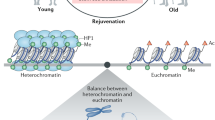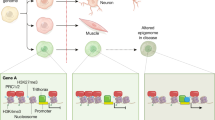Abstract
There is accumulating evidence that many chronic diseases such as type 2 diabetes and coronary heart disease might originate during early life. This evidence gives rise to the developmental origins of disease hypothesis, and is supported by epidemiological data in humans and experimental animal models. A perturbed environment in early life is thought to elicit a range of physiological and cellular adaptive responses in key organ systems. These adaptive changes result in permanent alterations and might lead to pathology in later life. Aging organs and cells seem therefore to retain a 'memory' of their fetal history and adaptive responses. The mechanisms underlying the developmental origins of disease remain poorly defined. Epigenetic tagging of genes, such as DNA methylation and histone modification, controls the function of the genome at different levels and maintains cellular memory after many cellular divisions; importantly, tagging can be modulated by the environment and is involved in onset of diseases such as cancer. Here we review the evidence for the developmental origins of disease and discuss the role of the epigenotype as a contributing mechanism. Environmentally induced changes in the epigenotype might be key primary events in the developmental origins of disease, with important clinical implications.
Key Points
-
Individuals with a low birth weight are at increased risk of developing type 2 diabetes, cardiovascular disease and the metabolic syndrome later in life
-
The fetal environment has a key role in mediating the relationship between early growth and adult disease
-
Epigenetic states can influence cellular physiology and affect disease risk and severity through associated chromatin and gene activity changes
-
Programmed changes in the epigenotype represent a major candidate molecular mechanism by which the early environment can lead to permanent changes in the phenotype
-
The identification of epigenotypes predictive of disease susceptibility would enable targeted intervention strategies to be employed
This is a preview of subscription content, access via your institution
Access options
Subscribe to this journal
Receive 12 print issues and online access
$209.00 per year
only $17.42 per issue
Buy this article
- Purchase on Springer Link
- Instant access to full article PDF
Prices may be subject to local taxes which are calculated during checkout


Similar content being viewed by others
References
Lucas A (1991) Programming by early nutrition in man. In The Childhood Environment and Adult Disease (CIBA Foundation Symposium 156), 38–55 (Eds Bock GR and Whelan J). Chichester, UK: John Wiley and sons
Hales CN and Barker DJP (2001) The thrifty phenotype hypothesis. Br Med Bull 60: 5–20
Hales CN and Barker DJP (1992) Type 2 (non-insulin-dependent) diabetes mellitus: the thrifty phenotype hypothesis. Diabetologia 35: 595–601
Neel JV (1962) Diabetes mellitus: a 'thrifty' genotype rendered detrimental by 'progress'. Am J Hum Genet 14: 353–362
Gluckman PD and Hanson MA (2004) Living with the past: evolution, development, and patterns of disease. Science 305: 1733–1736
Ozanne SE and Hales CN (2004) Lifespan: catch-up growth and obesity in male mice. Nature 427: 411–412
Poulsen P et al. (1997) Low birth weight is associated with NIDDM in discordant monozygotic and dizygotic twin pairs. Diabetologia 40: 439–446
Bo S et al. (2001) The metabolic syndrome in twins with increased susceptibility to type 2 diabetes mellitus. Diabet Med 17: 365–370
Ravelli AC et al. (1998) Glucose tolerance in adults after prenatal exposure to famine. Lancet 351: 173–177
Armitage JA et al. (2004) Developmental programming of the metabolic syndrome by maternal nutrition imbalance: how strong is the evidence from experimental models in mammals? J Physiol 561: 355–377
Hales CN and Ozanne SE (2003) For debate: fetal and early postnatal growth restriction lead to diabetes, the metabolic syndrome and renal failure. Diabetologia 46: 1013–1019
Garafano A et al. (1999) Effect of ageing on β cell mass and function in rats malnourished during the perinatal period. Diabetologia 42: 711–718
Khan IY et al. (2003) Gender-linked hypertension in offspring of lard-fed pregnant rats. Hypertension 41: 168–175
Lewis RM et al. (2002) Long-term programming of blood pressure by maternal dietary iron restriction in the rat. Br J Nutr 88: 283–290
Simmons RA et al. (2001) Intrauterine growth retardation leads to the development of type 2 diabetes in the rat. Diabetes 50: 2279–2286
Lindsay RS et al. (1996) Prenatal glucocorticoid exposure leads to offspring hyperglycaemia in the rat: studies with the 11 β-hydroxysteroid dehydrogenase inhibitor carbenoxolone. Diabetologia 39: 1299–1305
Stein AD and Lumey LH (2000) The relationship between maternal and offspring birth weights after maternal prenatal exposure: The Dutch Famine Cohort Study. Hum Biol 72: 641–654
Zambrano E et al. (2005) Sex differences in transgenerational alterations of growth and metabolism in progeny (F2) of female offspring (F1) of rats fed a low protein diet during pregnancy and lactation. J Physiol 566: 225–236
Drake AJ et al. (2005) Intergenerational consequences of fetal programming by in utero exposure to glucocorticoids in rats. Am J Physiol 288: R34–R38
Nyirenda MJ et al. (2006) Prenatal programming of hepatocyte nuclear factor 4 alpha in the rat. A key mechanism in the 'foetal origins of hyperglycaemia'? Diabetologia 49: 1412–1420
Nyirenda MJ et al. (1998) Glucocorticoid exposure in late gestation permanently programs rat hepatic phosphoenolpyruvate carboxykinase and glucocorticoid receptor expression and causes glucose intolerance in adult offspring. J Clin Invest 101: 2174–2181
Stoffers DA et al. (2003) Neonatal exendin-4 prevents the development of diabetes in the intrauterine growth retarded rat. Diabetes 52: 734–740
Waterland RA and Garza C (1999) Potential mechanisms of metabolic imprinting that lead to chronic disease. Am J Clin Nutr 69: 179–197
Jaenisch R and Bird A (2003) Epigenetic regulation of gene expression: how the genome integrates intrinsic and environmental signals. Nat Genet 33: 245–253
Gallou-Kabani C and Junien C (2005) Nutritional epigenomics of metabolic syndrome—new perspective against the epidemic. Diabetes 54: 1899–1906
Vickaryous N and Whitelaw E (2005) The role of early embryonic environment on epigenotype and phenotype. Reprod Fertil Dev 17: 335–340
Burn JE et al. (1993) DNA methylation, vernalization, and the initiation of flowering. Proc Natl Acad Sci USA 90: 287–291
Bastow R et al. (2004) Vernalization requires epigenetic silencing of FLC by histone methylation. Nature 427: 164–167
Weaver IC et al. (2004) Epigenetic programming by maternal behaviour. Nat Neurosci 7: 847–854
Peaston A and Whitelaw E (2006) Epigenetics and phenotypic variation in mammals. Mamm Genome 17: 365–374
Richards EJ (2006) Inherited epigenetic variation—revisiting soft inheritance. Nat Rev Genet 7: 395–401
Weksberg R et al. (2003) Beckwith-Wiedemann syndrome demonstrates a role for epigenetic control of normal development. Hum Mol Genet 12 (Spec No 1): R61–R68
Fraga MF et al. (2005) Epigenetic differences arise during the lifetime of monozygotic twins. Proc Natl Acad Sci USA 102: 10604–10609
Morgan HD et al. (1999) Epigenetic inheritance at the agouti locus in the mouse. Nat Genet 23: 314–318
Waterland RA and Jirtle RL (2003) Transposable elements: targets for early nutritional effects on epigenetic gene regulation. Mol Cell Biol 23: 5293–5300
Wolff GL et al. (1998) Maternal epigenetics and methyl supplements affect agouti gene expression in Avy/a mice. FASEB J 12: 949–957
Dolinoy DC et al. (2006) Maternal genistein alters coat color and protects Avy mouse offspring from obesity by modifying the fetal epigenome. Environ Health Perspect 114: 567–572
Waterland RA et al. (2006) Maternal methyl supplements increase offspring DNA methylation at Axin Fused. Genesis 44: 401–406
Waterland RA et al. (2006) Post-weaning diet affects genomic imprinting at the insulin-like growth factor 2 (Igf2) locus. Hum Mol Genet 15: 705–716
Lillycrop KA et al. (2005) Dietary protein restriction of pregnant rats induces and folic acid supplementation prevents epigenetic modification of hepatic gene expression in the offspring. J Nutr 135: 1382–1386
Bogdarina I et al. (2004) Investigation of the role of epigenetic modification of the rat glucokinase gene in fetal programming. Life Sci 74: 1407–1415
Newbold RR et al. (2000) Proliferative lesions and reproductive tract tumors in male descendants of mice exposed developmentally to diethylstilbestrol. Carcinogenesis 21: 1355–1363
Anway MD et al. (2005) Epigenetic transgenerational actions of endocrine disruptors and male fertility. Science 308: 1466–1469
Anway MD et al. (2006) Endocrine disruptor vinclozolin induced epigenetic transgenerational adult-onset disease. Endocrinology 147: 5515–5523
Chang H-S et al. (2006) Transgenerational epigenetic imprinting of the male germline by endocrine disruptor exposure during gonadal sex determination. Endocrinology 147: 5524–5541
Baylin SB and Ohm JE (2006) Epigenetic gene silencing in cancer—a mechanism for early oncogenic pathway addiction? Nat Rev Cancer 6: 107–116
Waterland RA and Jirtle R (2004) Early nutrition, epigenetic changes at transposons and imprinted genes, and enhanced susceptibility to adult chronic diseases. Nutrition 20: 63–68
Constância M et al. (2004) Resourceful imprinting. Nature 432: 53–57
Wilkins JF and Haig D (2003) What good is genomic imprinting: the function of parent-specific gene expression. Nat Rev Genet 4: 359–368
Angiolini E et al. (2006) Regulation of placental efficiency for nutrient transport by imprinted genes. Placenta 27 (Suppl A): S98–S103
Smith FM et al. (2006) Regulation of growth and metabolism by imprinted genes. Cytogenet Genome Res 113: 279–291
Mann MR et al. (2004) Selective loss of imprinting in the placenta following preimplantation development in culture. Development 131: 3727–3735
Niemitz EL and Feinberg AP (2004) Epigenetics and assisted reproductive technology: a call for investigation. Am J Hum Genet 74: 599–609
Issa JP et al. (1994) Methylation of the oestrogen receptor CpG island links aging and neoplasia in human colon. Nat Genet 7: 536–540
Issa JP et al. (2002) Epigenetic variation and human disease. J Nutr 132: 2388S–2392S
Feinberg AP et al. (2006) The epigenetic progenitor origin of human cancer. Nat Rev Genet 7: 21–33
Acknowledgements
SE Ozanne is a British Heart Foundation Lecturer and M Constância is a David Phillips Fellow (Biotechnology and Biological Sciences Research Council). The Authors would like to thank Dr I Sandovici and Dr N Smith for their help and critical reading of the manuscript.
Author information
Authors and Affiliations
Corresponding author
Ethics declarations
Competing interests
The authors declare no competing financial interests.
Related links
Rights and permissions
About this article
Cite this article
Ozanne, S., Constância, M. Mechanisms of Disease: the developmental origins of disease and the role of the epigenotype. Nat Rev Endocrinol 3, 539–546 (2007). https://doi.org/10.1038/ncpendmet0531
Received:
Accepted:
Issue Date:
DOI: https://doi.org/10.1038/ncpendmet0531
This article is cited by
-
Genome-wide analysis of DNA methylation in Hirschsprung enteric precursor cells: unraveling the epigenetic landscape of enteric nervous system development
Clinical Epigenetics (2021)
-
Role of chromatin assembly factor-1/p60 and poly [ADP-ribose] polymerase 1 in mycosis fungoides
Virchows Archiv (2021)
-
Association between gene promoter methylation of the one-carbon metabolism pathway and serum folate among patients with hyperhomocysteinemia
European Journal of Clinical Nutrition (2020)
-
RETRACTED ARTICLE: Amelioration of obsessive-compulsive disorder in three mouse models treated with one epigenetic drug: unraveling the underlying mechanism
Scientific Reports (2019)
-
Dual Effect of IL-6 -174 G/C Polymorphism and Promoter Methylation in the Risk of Coronary Artery Disease Among South Indians
Indian Journal of Clinical Biochemistry (2019)



